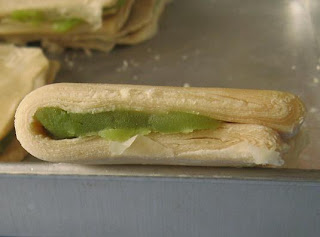 |
| Crackling Tiger on Emerald Lake |
Deep-frying has always been my nemesis and even when I managed relative success, I still got badly burnt in the process. For a recent project, I armed myself with a wok cover in my left hand to shield me from splattering oil, but still managed to burn the tip of one finger of my right hand as I was lowering something into the hot oil.
So it was with trepidation that I decided to make lotus seed paste crêpes for February's "Don't Call Me Chef" cookery column on our favourite Chinese dishes (here's the link to the pdf). These confection are seldom found outside of restaurants and are often served as the final course at a Chinese wedding banquet. Traditionally, they are deep-fried.
The pastry "skin" is made from a combination of two kinds of dough, one containing water, the other is a mixture of flour and shortening. It's the rolling and folding of these two dough together that produce crisp, flaky layers, much like "Western" puff pastry. I have made puff pastry and I think this Chinese pastry skin is much easier to handle.
It was the frying that consistently ruined my efforts. They say third time's the charm, but after four failed attempts at deep-frying – the outside burns before the inside cooks or it just soaks up the oil; look, I know it's because the oil is either too hot or not hot enough or there's too little of it... I admit I am lousy at it – I decided to give up and use the oven. The crêpe doesn't have the same crispness or dark golden colour that comes with deep-frying but I think the difference is negligible when the result is edible.
Lotus paste comes in 1kg packets and I had wondered what I was going to do with all the leftover, but after making it five times, only 1½ cups of it remained. I made some cupcakes using the paste in a filling and you can find the recipe in the post just before this one ("In lotus pose"). For the benefit of those who didn't get to this site through The Star, here's the recipe for the crêpe. (By the way, the paste in the newspaper was fluorescent green due to a printing error. It should be emerald, as in the pictures here, and that inspired the evocative name "Crackling Tiger on Emerald Lake", the tiger referring to this coming lunar new year of course.)
 |
| Beautiful bars |
BAKED LOTUS SEED PASTE CRÊPE
Serves 2-31¾ cups lotus seed paste (red bean is a good substitute), divided into 4 portions
Some oil and sesame seeds to garnish
Water dough
¾ cup unbleached plain flour
1 tablespoon icing sugar
1 tablespoon shortening (I use Crisco)
3-4 tablespoons water
Oil dough
½ cup cake flour, sifted
3 tablespoons shortening
Water dough: Sift the flour and icing sugar together. Rub in the shortening, then gradually add the water until the mixture comes together (you may not need to add all the water). It will hold together but will be stiff and stringy; knead for 3-4 minutes and the dough will become smooth and elastic.
Oil dough: Combine the ingredients and press together into a ball. This dough will hold together but be a little powdery.
- Cover both dough and set aside to rest for 30 minutes.
- Preheat the oven to 190°C. Divide the water and oil dough into 4 portions for easy handling. Roll or press out the water dough into a disk and place the oil dough in the centre, then wrap the water dough around it to enclose and form into a ball.
- Roll out the dough into a long oval (pic 1), then roll into a Swiss roll (pic 2). Give the dough a quarter turn (pic 3) and roll out lengthwise again. Make a Swiss roll again, give it another quarter turn and finally, roll out into a rough rectangle (pic 4). Spread one portion of lotus paste on one half of the pastry and fold the other half over (pix below).
 |
| Multiple strata are produced after the pastry has been rolled out. When baked, they puff up into flaky layers. |
- Place pastry in a baking tray. Brush oil on the top and scatter with sesame seeds, lightly pressing them into the pastry. Bake for 20-25 minutes until puffed and golden. Serve cut into bars.
PRINTABLE RECIPE
Postscript (Feb 13, 2010)
Katie emailed me after this post came out to ask if the Chinese pastry skin freezes well. I thought it might since most pastries can be frozen. Well, I tried it over the weekend and here's my report.
I made the pastry skin up to the final roll. One batch I froze without the filling, and another I filled with the lotus paste (both types were wrapped in cling film before freezing). For the unfilled pastry, take out of the freezer and thaw for 30-45 minutes before spreading with the lotus paste and then bake as usual. For the filled pastry, I put it straight in the preheated oven and baked for 5 minutes longer than asked for the recipe.
Result: The batch without the filling worked well. I wasn't as pleased with the one frozen with the filling. The outside layers crisped up, but the inside was a little dense and uncooked.



No comments:
Post a Comment
Your views are welcome and appreciated. Have a nice day!